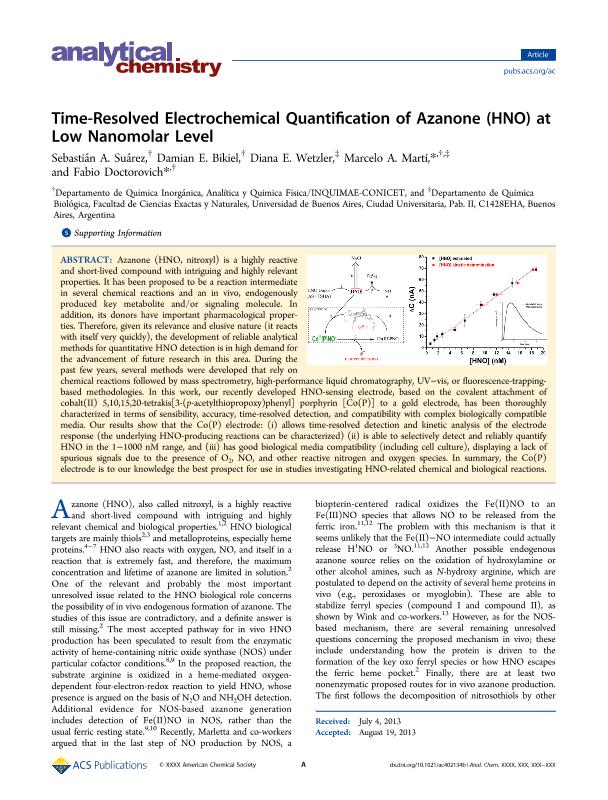Artículo
Time-resolved electrochemical quantification of azanone (HNO) at low nanomolar level
Suarez, Sebastian A.; Bikel, Damian E.; Wetzler, Diana Elena ; Marti, Marcelo Adrian
; Marti, Marcelo Adrian ; Doctorovich, Fabio
; Doctorovich, Fabio
 ; Marti, Marcelo Adrian
; Marti, Marcelo Adrian ; Doctorovich, Fabio
; Doctorovich, Fabio
Fecha de publicación:
19/08/2013
Editorial:
American Chemical Society
Revista:
Analytical Chemistry
ISSN:
0003-2700
Idioma:
Inglés
Tipo de recurso:
Artículo publicado
Clasificación temática:
Resumen
Azanone (HNO, nitroxyl) is a highly reactive and short-lived compound with intriguing and highly relevant properties. It has been proposed to be a reaction intermediate in several chemical reactions and an in vivo, endogenously produced key metabolite and/or signaling molecule. In addition, its donors have important pharmacological properties. Therefore, given its relevance and elusive nature (it reacts with itself very quickly), the development of reliable analytical methods for quantitative HNO detection is in high demand for the advancement of future research in this area. During the past few years, several methods were developed that rely on chemical reactions followed by mass spectrometry, high-performance liquid chromatography, UV-vis, or fluorescence-trapping-based methodologies. In this work, our recently developed HNO-sensing electrode, based on the covalent attachment of cobalt(II) 5,10,15,20-tetrakis[3-( p -acetylthiopropoxy)phenyl] porphyrin [Co(P)] to a gold electrode, has been thoroughly characterized in terms of sensibility, accuracy, time-resolved detection, and compatibility with complex biologically compatible media. Our results show that the Co(P) electrode: (i) allows time-resolved detection and kinetic analysis of the electrode response (the underlying HNO-producing reactions can be characterized) (ii) is able to selectively detect and reliably quantify HNO in the 1?1000 nM range, and (iii) has good biological media compatibility (including cell culture), displaying a lack of spurious signals due to the presence of O 2 , NO, and other reactive nitrogen and oxygen species. In summary, the Co(P) electrode is to our knowledge the best prospect for use in studies investigating HNO-related chemical and biological reactions.
Palabras clave:
Azone
,
Sensor
,
Electrochmical
Archivos asociados
Licencia
Identificadores
Colecciones
Articulos(INQUIMAE)
Articulos de INST.D/QUIM FIS D/L MATERIALES MEDIOAMB Y ENERGIA
Articulos de INST.D/QUIM FIS D/L MATERIALES MEDIOAMB Y ENERGIA
Citación
Suarez, Sebastian A.; Bikel, Damian E.; Wetzler, Diana Elena; Marti, Marcelo Adrian; Doctorovich, Fabio; Time-resolved electrochemical quantification of azanone (HNO) at low nanomolar level; American Chemical Society; Analytical Chemistry; 85; 21; 19-8-2013; 10262-10269
Compartir
Altmétricas



